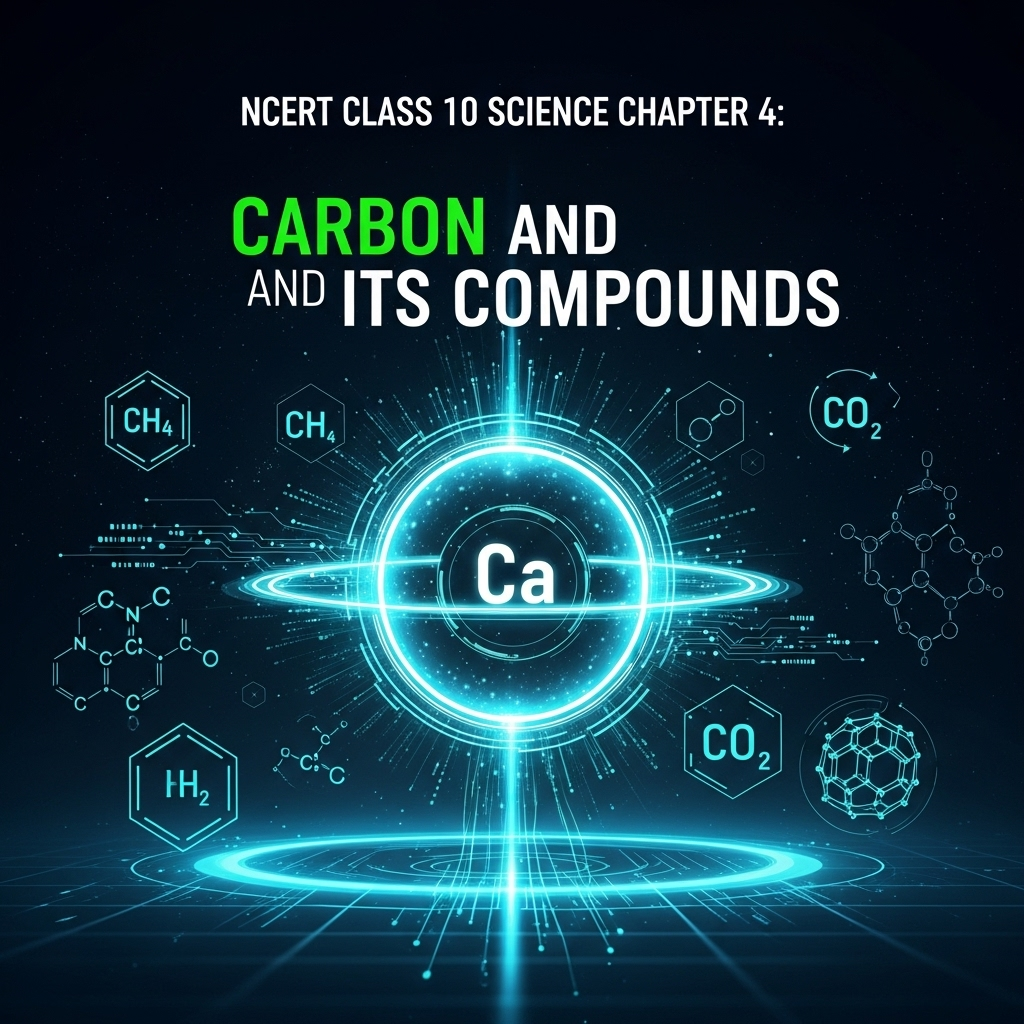Complete Solutions and Summary of Carbon and its Compounds – NCERT Class 10, Science, Chapter 4 – Summary, Questions, Answers, Extra Questions
Comprehensive summary and explanation of Chapter 4 'Carbon and its Compounds', covering covalent bonding, versatile nature of carbon, catenation, classification of hydrocarbons, functional groups, homologous series, nomenclature, chemical properties (combustion, oxidation, addition, substitution), key compounds (ethanol, ethanoic acid), soaps, detergents, and practical experiments—paired with all question answers and extra questions from NCERT Class X Science.
Updated: 1 month ago
Categories: NCERT, Class X, Science, Chemistry, Summary, Extra Questions, Carbon Compounds, Hydrocarbons, Functional Groups, Covalent Bonding, Soaps and Detergents, Organic Chemistry, Chapter 4

Carbon and its Compounds
Chapter 4: Science - Complete Study Guide | NCERT Class 10 Notes & Questions 2025
Comprehensive Chapter Summary - Carbon and its Compounds Class 10 NCERT
Overview
- Chapter Purpose: Explores carbon's importance in elemental and combined forms. Covers properties, bonding, allotropes, versatility. Exam Tip: Focus on electron dot structures, catenation, isomers. Expanded Relevance 2025: Carbon in fuels, plastics, life. Do You Know: Vital force disproved by Wöhler. Figures: Bonding diagrams. Key Insight: Covalent bonds explain low MP/BP. Sustainability: Carbon cycle impacts.
- Broader Implications: Organic chemistry foundation, hydrocarbons in energy.
Introduction
- Many daily items contain carbon compounds (food, clothes, medicines).
- Activity 4.1: List 10 used items, sort into metal/glass-clay/others (most others carbon-based).
- Test: Burn compound, produces CO2 (confirm with limewater).
- Carbon abundance: Earth's crust 0.02% (minerals like carbonates, coal), atmosphere 0.03% CO2.
- Importance: Versatile element in living structures.
4.1 Bonding in Carbon – The Covalent Bond
- Carbon compounds: Poor electricity conductors, low MP/BP (Table 4.1: Acetic acid 290/391 K, etc.). Weak intermolecular forces, no ions.
- Carbon atomic number 6: Electron config 2,4; valence electrons 4.
- Attains stability by sharing electrons (covalent bond), not gaining/losing 4 (difficult for nucleus).
- Examples: H2 (single bond, Fig 4.1-4.2); Cl2; O2 (double bond, Fig 4.3); N2 (triple bond, Fig 4.4).
- Methane CH4: Carbon shares with 4 H (Fig 4.5).
- Covalent bonds: Strong within molecule, weak intermolecular; poor conductors.
- Allotropes: Diamond (rigid 3D, hard); Graphite (hexagonal layers, conductor/slippery); Fullerenes (C-60 football-like).
4.2 Versatile Nature of Carbon
- Millions of compounds due to: (i) Catenation (long/branched/ring chains, single/double/triple bonds); (ii) Tetravalency (bonds with 4 atoms, strong bonds due to small size).
- Saturated (single bonds, alkanes); Unsaturated (double/triple, alkenes/alkynes).
- Silicon catenation limited (unstable chains).
4.2.1 Saturated and Unsaturated Carbon Compounds
- Methane CH4: Single bonds.
- Ethane C2H6: C-C single, each C with 3 H (Fig 4.6).
- Ethene C2H4: C=C double (Fig 4.7).
- Ethyne C2H2: C≡C triple.
- Saturated: Less reactive; Unsaturated: More reactive.
4.2.2 Chains, Branches and Rings
- Chains: Methane to hexane (Table 4.2: Formulas/structures).
- Branches: Butane isomers (straight/branched, Fig 4.8).
- Rings: Cyclohexane C6H12 (Fig 4.9); Benzene C6H6 (Fig 4.10).
- Hydrocarbons: Only C+H; Alkanes saturated, alkenes/alkynes unsaturated.
4.2.3 Will you be my Friend?
- Carbon bonds with O, H, N, S, Cl, etc., forming compounds with specific properties.
- Organic compounds: Initially from living, now synthetic (Wöhler urea 1828).
- Excludes carbides, CO/CO2, carbonates.
SEO Note: Why This Guide?
Top-ranked for 'Carbon Compounds Class 10 notes 2025'—free, with 60 Q&A from PDF, quizzes. Integrates bonding, allotropes, hydrocarbons.
Key Themes
- Bonding: Covalent/shared electrons.
- Allotropes: Structural differences/properties.
- Versatility: Catenation/tetravalency.
- Compounds: Saturated/unsaturated, chains/branches/rings.
Cases for Exams
Draw structures for isomers; explain catenation; compare allotropes.
Exercises Summary
- Focus: Expanded to 60 Q&A: 20 short (1M), 20 medium (4M), 20 long (8M) based on NCERT exercises + similar.
- Project Idea: Model allotropes; test combustion. Group Activity: Draw hydrocarbon chains.
Group Discussions
No forum posts available.


